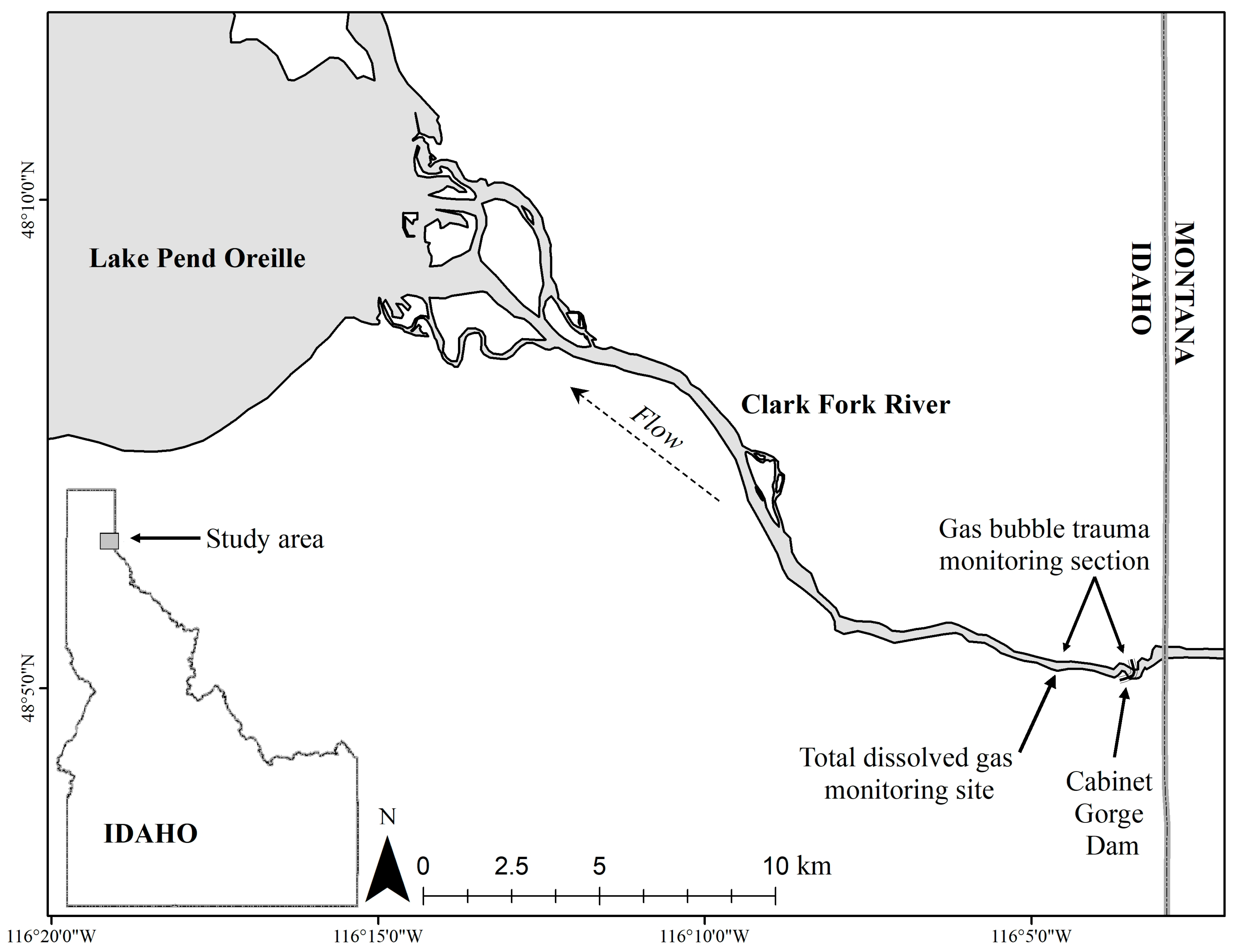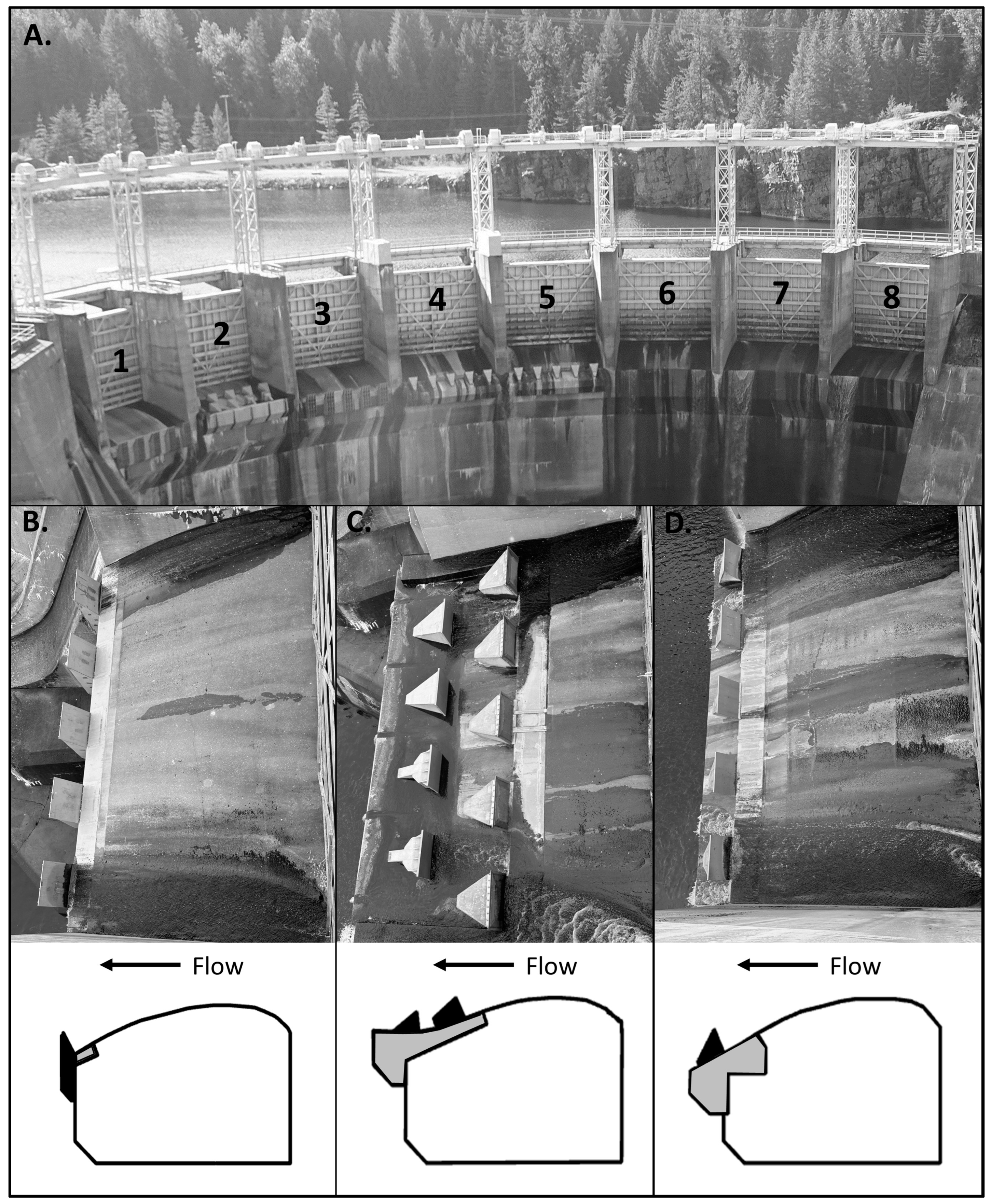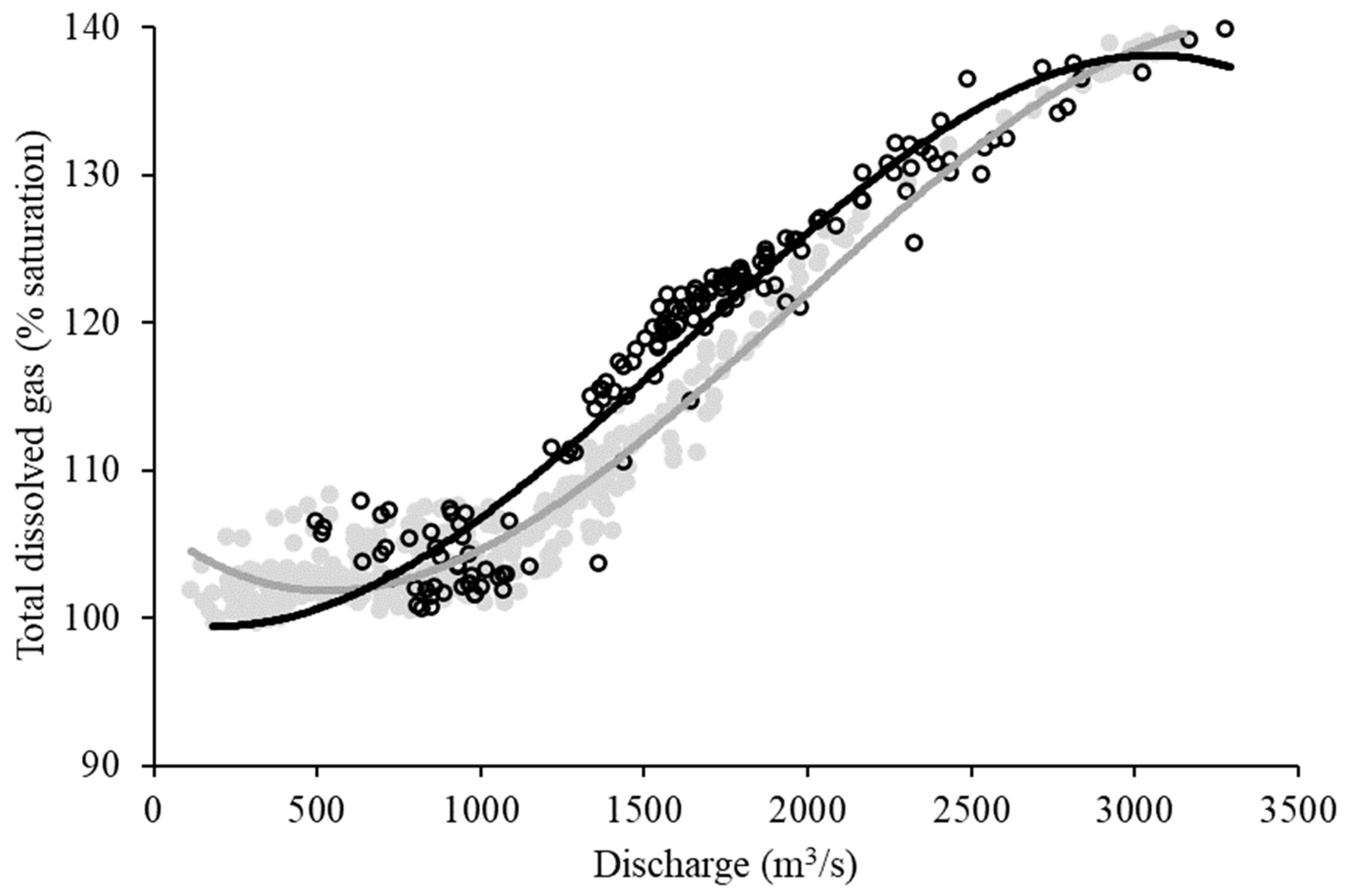Reducing Total Dissolved Gas and Gas Bubble Trauma in a Regulated River
Abstract
1. Introduction
2. Materials and Methods
2.1. Study Area
2.2. Spill Bay Modifications
2.3. Data Collection
2.4. Data Analysis
3. Results
3.1. Total Dissolved Gas Relationship to Discharge
3.2. Total Dissolved Gas
3.3. Gas Bubble Trauma
4. Discussion
5. Conclusions
Funding
Institutional Review Board Statement
Informed Consent Statement
Data Availability Statement
Acknowledgments
Conflicts of Interest
References
- Bouck, G.R. Etiology of gas bubble disease. Trans. Am. Fish. Soc. 1980, 109, 703–707. [Google Scholar] [CrossRef]
- Weitkamp, D.E.; Katz, M. A review of dissolved gas supersaturation literature. Trans. Am. Fish. Soc. 1980, 109, 659–702. [Google Scholar] [CrossRef]
- Bouck, G.R.; Chapman, G.A.; Schneider Jr, P.W.; Stevens, G. Observations on gas bubble disease among wild adult Columbia River fishes. Trans. Am. Fish. Soc. 1976, 105, 114–115. [Google Scholar] [CrossRef]
- Backman, T.W.; Evans, A.F. Gas bubble trauma incidence in adult salmonids in the Columbia River Basin. N. Am. J. Fish. Manag. 2002, 22, 579–584. [Google Scholar] [CrossRef]
- Pleizier, N.K.; Algera, D.; Cooke, S.J.; Brauner, C.J. A meta-analysis of gas bubble trauma in fish. Fish Fish. 2020, 21, 1175–1194. [Google Scholar] [CrossRef]
- Counihan, T.D.; Miller, A.I.; Mesa, M.G.; Parsley, M.J. The effects of dissolved gas supersaturation on White Sturgeon larvae. Trans. Am. Fish. Soc. 1998, 127, 316–322. [Google Scholar] [CrossRef]
- Schiewe, M.H. Influence of dissolved atmospheric gas on swimming performance of juvenile Chinook Salmon. Trans. Am. Fish. Soc. 1974, 103, 717–721. [Google Scholar] [CrossRef]
- Dawley, E.M.; Ebel, W.J. Effects of various concentrations of dissolved atmospheric gas on juvenile Chinook Salmon and steelhead trout. U.S. Nat. Mar. Fish. Serv. Fish. Bull. 1975, 73, 777–796. [Google Scholar]
- Fickeisen, D.H.; Montgomery, J.C. Tolerances of fishes to dissolved gas supersaturation in deep tank bioassays. Trans. Am. Fish. Soc. 1978, 107, 376–381. [Google Scholar] [CrossRef]
- Dawley, E.M.; Schiewe, M.; Monk, B. Effects of long-term exposure to supersaturation of dissolved atmospheric gases on juvenile chinook salmon and steelhead trout in deep and shallow test tanks. In Gas Bubble Disease; Fickeisen, D.H., Schneider, M.J., Eds.; Energy Research and Development Administration, Technical Information Center: Richland, WA, USA, 1976; pp. 1–10. [Google Scholar]
- Shrimpton, J.M.; Randall, D.J.; Fidler, L.E. Assessing the effects of positive buoyancy on rainbow trout (Oncorhynchus mykiss) held in gas supersaturated water. Can. J. Zool. 1990, 68, 969–973. [Google Scholar] [CrossRef]
- Pleizier, N.K.; Rost-Komiya, B.; Cooke, S.J.; Brauner, C.J. The lack of avoidance of total dissolved gas supersaturation in juvenile rainbow trout. Hydrobiologia 2021, 848, 4837–4850. [Google Scholar] [CrossRef]
- Ji, Q.; Li, K.; Wang, Y.; Liang, R.; Feng, J.; Yuan, Q.; Zhang, P.; Zhu, D.Z. Total dissolved gases induced tolerance and avoidance behaviors in pelagic fish in the Yangtze River, China. Ecotoxicol. Environ. Saf. 2021, 216, 112218. [Google Scholar] [CrossRef] [PubMed]
- Crunkilton, R.L.; Czarnezki, J.M.; Trial, L. Severe gas bubble disease in a warmwater fishery in the midwestern United States. Trans. Am. Fish. Soc. 1980, 109, 725–733. [Google Scholar] [CrossRef]
- Lutz, D.S. Gas supersaturation and gas bubble trauma in fish downstream from a Midwestern reservoir. Trans. Am. Fish. Soc. 1995, 124, 423–436. [Google Scholar] [CrossRef]
- Ji, Q.; Xue, S.; Yuan, Q.; Yuan, Y.; Wang, Y.; Liang, R.; Feng, J.; Li, K.; Li, R. The tolerance characteristics of resident fish in the upper Yangtze River under varying gas supersaturation. Int. J. Environ. Res. Public Health 2019, 16, 2021. [Google Scholar] [CrossRef] [PubMed]
- Li, P.; Zhu, D.Z.; Li, R.; Wang, Y.; Crossman, J.A.; Kuhn, W.L. Production of total dissolved gas supersaturation at hydropower facilities and its transport: A review. Water Res. 2022, 223, 119012. [Google Scholar] [CrossRef]
- Latona (Latona Consulting Services, LLC). Final Report Total Dissolved Gas Monitoring 2014 Cabinet Gorge and Noxon Rapids Dams; Latona Consulting Services, LLC: Seattle, WA, USA, 2014. [Google Scholar]
- Weitkamp, D.E.; Sullivan, R.D.; Swant, T.; DosSantos, J. Gas bubble disease in resident fish of the lower Clark Fork River. Trans. Am. Fish. Soc. 2003, 132, 865–876. [Google Scholar] [CrossRef]
- Kusnierz, P.C.; Bouwens, K.A.; Ransom, A.L. Predicting the likelihood of gas bubble trauma in fishes exposed to elevated total dissolved gas in the lower Clark Fork River, Idaho. Trans. Am. Fish. Soc. 2024, 153, 39–54. [Google Scholar] [CrossRef]
- Nebeker, A.V.; Brett, J.R. Effects of air-supersaturated water on survival of Pacific salmon and steelhead smolts. Trans. Am. Fish. Soc. 1976, 105, 338–342. [Google Scholar] [CrossRef]
- Nebeker, A.V.; Hauck, A.K.; Baker, F.D.; Weitz, S.L. Comparative responses of speckled dace and cutthroat trout to air-supersaturated water. Trans. Am. Fish. Soc. 1980, 109, 760–764. [Google Scholar] [CrossRef]
- Avista (Avista Corporation). Application for New License, Volume III Settlement Agreement; Avista Corporation: Spokane, WA, USA, 1999. [Google Scholar]
- Avista (Avista Corporation). Addendum Final GAS Supersaturation Control Program for the Clark Fork Project; Avista Corporation: Spokane, WA, USA, 2009. [Google Scholar]
- Li, P.; Zhu, D.Z.; Crossman, J.; Cheng, X. Spillway deflector designs for mitigating supersaturated total dissolved gases. J. Clean. Prod. 2023, 426, 139027. [Google Scholar] [CrossRef]
- Maatooq, J.; Taleb, E. The effects of baffle blocks locations and blockage ratio on the sequent depth and velocity distribution of forced hydraulic jump. In Proceedings of the 7th IAHR International Symposium on Hydraulic Structures, Aachen, Germany, 15–17 May 2018. [Google Scholar] [CrossRef]
- Huang, J.; Li, R.; Feng, J.; Li, Z.; Cheng, X.; Wang, Z. The application of baffle block in mitigating TDGS of dams with different discharge patterns. Ecol. Indic. 2021, 133, 108418. [Google Scholar] [CrossRef]
- Frizell, K.E. Cavitation Potential of the Folsom Auxiliary Spillway Basin Baffle Blocks; Hydraulic Laboratory Report No. HL-1009-06; U.S. Department of the Interior, Bureau of Reclamation: Denver, CO, USA, 2009.
- Dunlop, S.L.; Willig, I.A.; Paul, G. Cabinet Gorge Dam Spillway modifications for TDG abatement—Design evolution and field performance. In Hydraulic Structures and Water System Management, Proceedings of the 6th IAHR International Symposium on Hydraulic Structures, Portland, OR, USA, 27–30 June 2016; Crookston, B., Tullis, B., Eds.; 2016. [Google Scholar] [CrossRef]
- Weber, L.; Huang, H.; Lai, Y.; McCoy, A. Modeling total dissolved gas production and transport downstream of spillways: Three-dimensional development and applications. Int. J. River Basin Manag. 2004, 2, 157–167. [Google Scholar] [CrossRef]
- Politano, M.; Amado, A.A.; Bickford, S.; Murauskas, J.; Hay, D. Evaluation of operational strategies to minimize gas supersaturation downstream of a dam. Compt. Fluids 2012, 68, 168–185. [Google Scholar] [CrossRef]
- Zapel, E.; Nelson, H.; Hughes, B.; Fry, S. Options for reducing total dissolved gas at the Long Lake Hydroelectric Facility. In Proceedings of the HydroVision International 2014 Technical Paper, Nashville, TN, USA, 22–24 July 2014. [Google Scholar]
- Jalayeri, N.; Groeneveld, J.; Bearlin, A.; Gulliver, J. Boundary Dam TDG (total dissolved gas) analysis using a CFD Model. In Proceedings of the 23rd Canadian Hydrotechnical Conference, Held as Part of the Canadian Society for Civil Engineering Annual Conference and General Meeting, Vamcouver, BC, Canada, 31 May–3 June 2017; pp. 73–83. [Google Scholar]
- Oldenburg, E. Tributary Trapping and Downstream Juvenile Bull Trout Transport Program Annual Project Update—2017; Avista Corporation: Noxon, MT, USA, 2018. [Google Scholar]
- Bernall, S.; Duffy, K. Upstream Fish Passage Program—Bull Trout, Annual Project Update—2018; Avista Corporation: Noxon, MT, USA, 2019. [Google Scholar]
- Bernall, S.; Johnson, J.; Kusnierz, P. Clark Fork River Westslope Cutthroat Trout Experimental Transport Program Comprehensive Project Report 2015–2018; Avista Corporation: Noxon, MT, USA, 2021. [Google Scholar]
- Scarnecchia, D.L.; Lim, Y.; Moran, S.P.; Tholl, T.D.; Dos Santos, J.M.; Breidinger, K. Novel fish communities: Native and non-native species trends in two run-of-the-river reservoirs, Clark Fork River, Montana. Rev. Fish. Sci. Aquacult. 2014, 22, 97–111. [Google Scholar] [CrossRef]
- Kusnierz, P. Cabinet Gorge Dam Spillway Modifications to Reduce Total Dissolved Gas Summary Report; Avista Corporation: Noxon, MT, USA, 2019. [Google Scholar]
- USGS Water Data for the Nation. Available online: https://waterdata.usgs.gov/nwis (accessed on 19 September 2023).
- Dunlop, S.; Paul, G.; Pate, K. Partnering to mitigate TDG through spillway modifications. Hydro Rev. 2014, 33, 16–24. [Google Scholar]
- USGS (U.S. Geological Survey). Protocol for Determining Gas Bubble Trauma in Juvenile Salmonids; U.S. Geological Survey: Cook, MT, USA, 1997.
- Arnold, T.B.; Emerson, J.W. Nonparametric goodness-of-fit tests for discrete null distributions. R J. 2011, 3, 34–39. [Google Scholar] [CrossRef]
- Fox, J. The R Commander: A basic-statistics graphical user interface to R. J. Stat. Softw. 2005, 14, 1–42. [Google Scholar] [CrossRef]
- Parametrix. Characterization of Dissolved Gas Conditions at Cabinet Gorge and Noxon Rapids Hydroelectric Projects During Spill Periods; Parametrix, Inc.: Kirkland, WA, USA, 1996. [Google Scholar]
- Parametrix. Physical and Biological Evaluations of Total Dissolved Gas Conditions at Cabinet Gorge and Noxon Rapids Hydroelectric Projects—1997; Parametrix, Inc.: Kirkland, WA, USA, 1997. [Google Scholar]
- Vilberg, I.; Szabo-Meszaros, M.; Pulg, U.; Velle, G. Supersaturation in Hydropower Installations; Report No: 2023:01201; SINTEF Energy Research: Trondheim, Norway, 2023. [Google Scholar]
- Macdonald, J.R.; Hyatt, R.A. Supersaturation of nitrogen in water during passage through hydroelectric turbines at Mactaquac Dam. J. Fish. Res. Bd. Can. 1973, 30, 1392–1394. [Google Scholar] [CrossRef]
- Pulg, U.; Vollset, K.W.; Velle, G.; Stranzl, S. First observations of saturopeaking: Characteristics and implications. Sci. Total Environ. 2016, 573, 1615–1621. [Google Scholar] [CrossRef]
- Rognerud, M.E. How to Avoid Gas Supersaturation in the River Downstream a Hydropower Plant. Master’s Thesis, Norwegian University of Science and Technology, Trondheim, Norway, 2020. [Google Scholar]
- Kuhn, W.L.; Solemslie, B.W.; Hihn, J.-Y.; Dahlhaug, O.G. Evaluating natural degassing in a river to create a baseline for comparison to technical degassing methods. J. Phys. Conf. Ser. 2023, 2629, 012032. [Google Scholar] [CrossRef]
- Sanchez-Hernandez, J. Drivers of piscivory in a globally distributed aquatic predator (brown trout): A meta-analysis. Sci. Rep. 2020, 10, 11258. [Google Scholar] [CrossRef]
- Gard, M.F. Interactions between an introduced piscivore and a native piscivore in a California stream. Environ. Biol. Fishes 2004, 71, 287–295. [Google Scholar] [CrossRef]
- Hill, C.W. Observations on the life histories of the peamouth (Mylocheilus caurinus) and the northern squawfish (Ptychocheilus oregonensis) in Montana. Proc. Mont. Acad. Sci. 1962, 22, 27–44. [Google Scholar]
- Muhlfeld, C.C.; McMahon, T.E.; Belcer, D.; Kershner, J.L. Spatial and temporal spawning dynamics of native westslope cutthroat trout, Oncorhynchus clarkii lewisi, introduced rainbow trout, Oncorhynchus mykiss, and their hybrids. Can. J. Fish. Aquat. Sci. 2009, 66, 1153–1168. [Google Scholar] [CrossRef]
- Schreck, C.B.; Contreras-Sanchez, W.; Fitzpatrick, M.S. Effects of stress on fish reproduction, gamete quality, and progeny. In Reproductive Biotechnology in Finfish Aquaculture; Lee, C., Donaldson, E.M., Eds.; Elsevier Science: Amsterdam, The Netherlands, 2001; pp. 3–24. [Google Scholar]
- Witt, A.; Magee, T.; Stewart, K.; Hadjerioua, B.; Neumann, D.; Zagona, E.; Politano, M. Development and implementation of an optimization model for hydropower and total dissolved gas in the Mid-Columbia River system. J. Water Resour. Plan Manag. 2017, 143, 04017063. [Google Scholar] [CrossRef]
- Politano, M.; Arenas Amado, A.; Anderson, K. Validation of a numerical model to predict TDG in Hells Canyon Dam. Aust. J. Water Resour. 2014, 18, 162–179. [Google Scholar]
- Andriolo, M.V.; de Araújo, A.N.; Fontanelli, C.; Paranhos, C.S.A.; Politano, M.; Dettmer, P.H.C. Installation of deflector in Colider Dam to minimize the percentual of total dissolved gases. Braz. J. Water Resour. 2023, 28, e25. [Google Scholar] [CrossRef]
- Deng, Z.D.; Duncan, J.P.; Arnold, J.L.; Fu, T.; Martinez, J.; Lu, J.; Titzler, P.S.; Zhou, D.; Mueller, R.P. Evaluation of Boundary Dam spillway using an autonomous sensor fish device. J. Hydro-Environ. Res. 2017, 14, 85–92. [Google Scholar] [CrossRef]






| Spill Bay | Modification Description | Design Capacity (m3/s per Spill Bay) | Year Completed |
|---|---|---|---|
| 2 | Two offset rows of steel-covered roughness elements (five upstream and four downstream) with an extension flip lip at the downstream end of the spill bay ogee | 170 | 2014 |
| 4 and 5 | Five steel-covered roughness elements at the downstream end of the spill bay ogee | 204 | 2016 |
| 1 and 3 | Five steel plates affixed to the front of the spill bay | 204 | 2017 |
| Relationship | r2 | a | b | c | d |
|---|---|---|---|---|---|
| Pre-modification | 0.94 | −3.32 × 10−9 | 1.6253 × 10−5 | −6.2031 × 10−3 | 100.0530 |
| Post-modification | 0.96 | −3.34 × 10−9 | 1.9560 × 10−5 | −1.7936 × 10−2 | 106.3337 |
| Scenario | Relationship | Days When Total Dissolved Gas Exceeded | ||
|---|---|---|---|---|
| 110% Saturation | 120% Saturation | 130% Saturation | ||
| Median | Pre-modification | 42 | 3 | 0 |
| Post-modification | 35 | 0 | 0 | |
| Difference | −7 | −3 | NC | |
| 75th percentile | Pre-modification | 72 | 43 | 6 |
| Post-modification | 58 | 32 | 0 | |
| Difference | −14 | −11 | −6 | |
| Scenario | Relationship | Days When the Probability of Observing Gas Bubble Trauma Is | |||
|---|---|---|---|---|---|
| >0.01 | >0.02 | >0.04 | >0.08 | ||
| Median | Pre-modification | 39 | 15 | 0 | 0 |
| Post-modification | 18 | 0 | 0 | 0 | |
| Difference | −21 | −15 | NA | NA | |
| 75th percentile | Pre-modification | 63 | 49 | 40 | 19 |
| Post-modification | 49 | 41 | 21 | 6 | |
| Difference | −14 | −8 | −19 | −13 | |
Disclaimer/Publisher’s Note: The statements, opinions and data contained in all publications are solely those of the individual author(s) and contributor(s) and not of MDPI and/or the editor(s). MDPI and/or the editor(s) disclaim responsibility for any injury to people or property resulting from any ideas, methods, instructions or products referred to in the content. |
© 2024 by the author. Licensee MDPI, Basel, Switzerland. This article is an open access article distributed under the terms and conditions of the Creative Commons Attribution (CC BY) license (https://creativecommons.org/licenses/by/4.0/).
Share and Cite
Kusnierz, P.C. Reducing Total Dissolved Gas and Gas Bubble Trauma in a Regulated River. Fishes 2024, 9, 427. https://doi.org/10.3390/fishes9110427
Kusnierz PC. Reducing Total Dissolved Gas and Gas Bubble Trauma in a Regulated River. Fishes. 2024; 9(11):427. https://doi.org/10.3390/fishes9110427
Chicago/Turabian StyleKusnierz, Paul C. 2024. "Reducing Total Dissolved Gas and Gas Bubble Trauma in a Regulated River" Fishes 9, no. 11: 427. https://doi.org/10.3390/fishes9110427
APA StyleKusnierz, P. C. (2024). Reducing Total Dissolved Gas and Gas Bubble Trauma in a Regulated River. Fishes, 9(11), 427. https://doi.org/10.3390/fishes9110427





